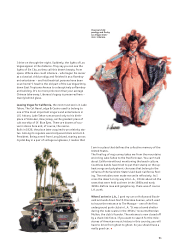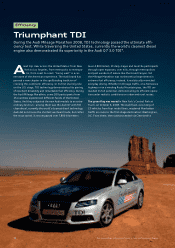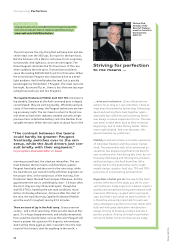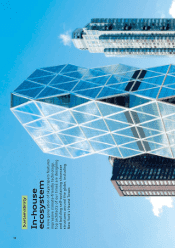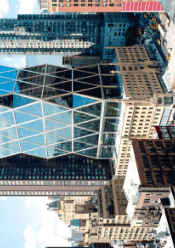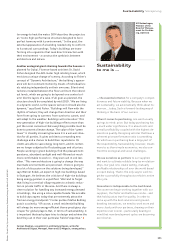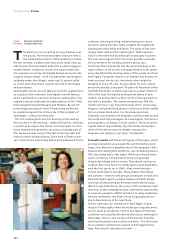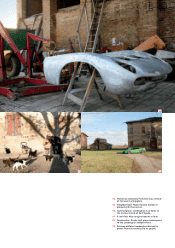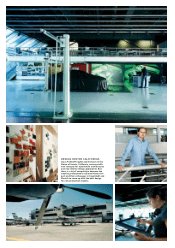Audi 2008 Annual Report Download - page 104
Download and view the complete annual report
Please find page 104 of the 2008 Audi annual report below. You can navigate through the pages in the report by either clicking on the pages listed below, or by using the keyword search tool below to find specific information within the annual report.
101
Sustainability
to me is …
Ulf Berkenhagen,
Member of the
Board of Manage-
ment for Purchas-
ing, AUDI AG
… the essential criterion for a company’s compet-
itiveness and future viability. Because when we
act sustainably, we automatically think about to-
morrow … today. Such a forward-looking way of
thinking is the basis of our success.
When it comes to purchasing, one word usually
springs to mind: price. But today purchasing has
a much wider significance. It is about costs and
overall profitability coupled with the highest de-
mands on quality. Designing vehicles that have a
coherent price-performance ratio is something
for which we in purchasing bear a large part of
the responsibility. Sustainability, however, means
more to us than simple economics; we also con-
front the ecological and social challenges.
We see ourselves as partners to our suppliers
and want to cultivate reliable long-term relation-
ships. Our goal is to create lasting, mutually
profitable relationships all over the world based
on open dialog. That is the only way to work to-
gether successfully throughout a vehicle’s entire
life cycle.
Innovation is indispensable to the Audi brand.
The sooner we begin working together with our
suppliers, the faster and better we can be – and
that holds just as true for quality. In order to
come up with the best solutions and ground-
breaking innovations, we need to work more and
more closely with our partners, drawing on their
expertise ever sooner – particularly bearing in
mind that new development cycles are becoming
ever shorter.
Photos: Chuck Choi, Dynamic Architecture; Skidmore Owings & Merrill LLP, AUDI AG
lar energy to heat the water. SOM describes the project as
an “iconic high-performance structure designed to be in
perfect harmony with its environment.” In the past, the
external appearance of a building needed only to conform
to its natural surroundings. Today’s buildings are trans-
forming into organisms that seek direct interaction with
their environment – a constructive symbiosis between
architecture and nature.
Another ecological giant straining towards the heavens is
planned for Dubai. Florence-based architect Dr. David
Fisher designed the 420-meter high rotating tower, which
envisions a unique change of scenery. According to Fisher’s
concept of “Dynamic Architecture,” the building’s appear-
ance will be in constant motion by means of individual lev-
els rotating independently on their own axes. Silent wind
turbines installed between the floors will turn the individ-
ual levels, which are going to be layered on a central col-
umn like the layers of a cake. If all goes as planned, the
structure should be completed by mid-2010. “We are living
in a dynamic world, so the spaces we live in should also be
dynamic,” says David Fisher. “Buildings will flow with the
rhythm of nature; they will change their direction and their
form from spring to summer, from sunrise to sunset, and
will adapt to the weather. Buildings will come alive.” This
new generation of high-rise buildings reflects more than
just the social consensus that everything possible must be
done to prevent climate change. The value of the “green
tower” is steadily increasing because it is a win-win situa-
tion for all parties. It gives architects a rewarding new
challenge and a chance to build their reputations. Its
clients are able to save energy long-term, and its renters
are no longer subjected to fluctuating gas and oil prices.
People working in green buildings find the pleasant tem-
peratures, abundant sunlight and well-filtered air much
more comfortable to work in – they even call in sick less
often. “This new architecture is going to change the way
manmade environments are perceived – there is going to
be a lot of discussion on the solutions being developed,”
says Werner Sobek, an expert in high-rise buildings based
in Stuttgart. He believes the criticism of high-rise buildings
being energy guzzlers is unjustified. “We tend to forget
that living in a vertical village equates to a drastic reduc-
tion in private traffic in the area. And there is always a
clever solution for handling any increased energy demand
in buildings, like using a solar-capable facade. We are able
to build skyscrapers today that are extremely attractive
from an energy standpoint.” Foster partner Stefan Behling
puts it succinctly: “Of course, a small residential building
will always be more energy-efficient than a prestigious sky-
scraper for global players. But, in terms of sustainability, it
is important that each player tries to design and achieve the
best they can in their own particular field of expertise.”
Carmen Stephan, a specialist in architectural topics, writes for
Architectural Digest, Monopol, Neon and SZ-Magazin, among others.
Sustainability Vorsprung


